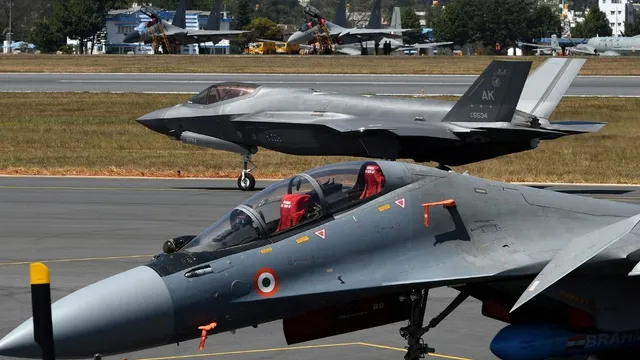- By Shivangi Sharma
- Thu, 20 Nov 2025 06:21 PM (IST)
- Source:JND
Russia has proposed an unprecedented technology-sharing deal with India, offering access to its most advanced fifth-generation stealth fighter jet, the Su-57, and potentially the Su-75 Checkmate. The offer, confirmed by Sergey Chemezov, CEO of state-owned defence conglomerate Rostec, could fundamentally reshape India’s air combat capabilities and defence-industrial future.
Chemezov announced that Moscow’s proposal involves initially supplying Su-57 fighters manufactured in Russia, followed by a phased transfer of production to India. If accepted, this would mark the first time any country has opened such deep access to fifth-generation fighter technology for India.
Reports also indicate that Russia may include its single-engine stealth jet, the Su-75 “Checkmate,” in the package, a move that would give India options across the stealth fighter spectrum.
Russia Signals Trust Ahead Of Putin’s India Visit
Russian President Vladimir Putin is scheduled to visit New Delhi in December for the 23rd India–Russia Annual Summit. The offer appears timed to reinforce long-standing military ties that have endured sanctions and supply-chain pressures.
Chemezov emphasised that Russia has always supported India through crises and restrictions. "Today, we continue the same approach… supplying India with whatever military equipment it needs,” he said, adding that Moscow remains open to any new requests, including additional S-400 systems or Su-57 fighters.
What Makes The Su-57 Special?
The Sukhoi Su-57, known by NATO as Felon, is Russia’s first fifth-generation fighter jet. At the 2025 Dubai Airshow, the export-ready Su-57E showcased its stealth design, advanced sensors, and super-manoeuvrability.
Key features include:
- Mach 2 cruise speeds
- Internal weapons bay, recently displayed publicly for the first time
- Stealth shaping and reduced infrared signature with new 2D thrust-vectoring nozzles
- Extreme manoeuvres at near-zero speeds due to advanced thrust-vectoring engines
- Compatibility with modern air-to-air and anti-radiation missiles
These capabilities place it in the same league as US F-22 and F-35 fighters.
Why India May Consider The Offer
The Indian Air Force faces a widening fighter squadron shortfall. Air Chief Marshal AP Singh has stated the IAF needs 35–40 new aircraft every year for the next two decades to meet national security goals under Roadmap 2047.
A collaboration on the Su-57 or Su-75 could:
- Strengthen India’s deterrence against regional rivals
- Accelerate indigenous stealth fighter development
- Reduce dependence on Western systems
- Support long-term manufacturing and export ambitions
If New Delhi accepts Russia’s proposal, it would gain access to technologies the West has consistently withheld, potentially giving India a decisive edge in future air combat.
ALSO READ: ‘From Red Fort to Kashmir’: Pakistan Leader Publicly Admits Role In Terror Attacks Across India

